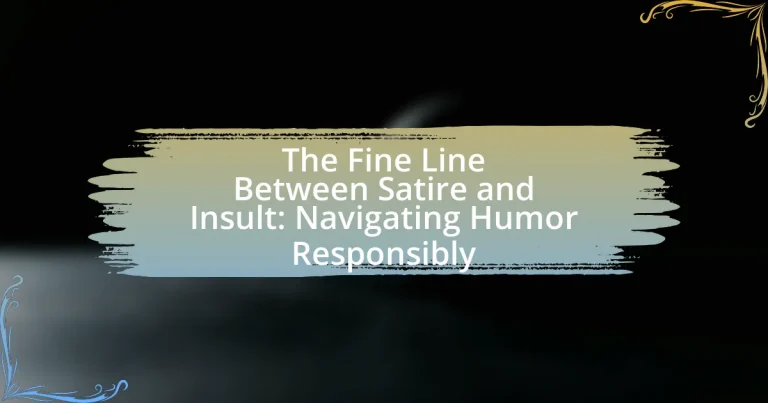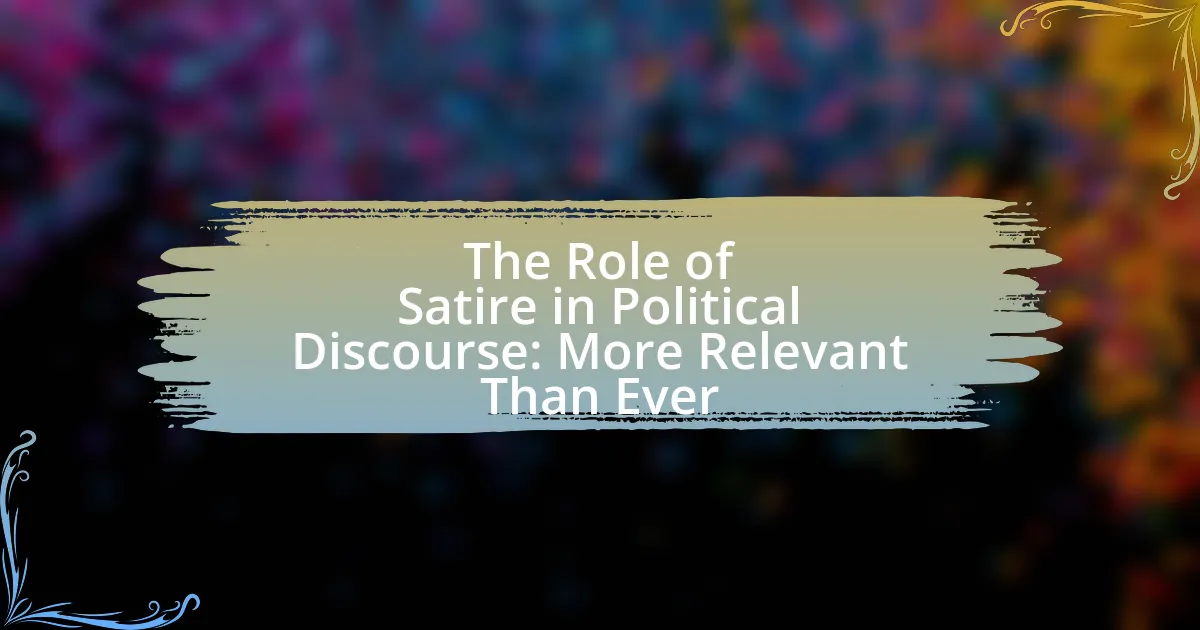The article examines the distinction between satire and insult, emphasizing the importance of intent and context in humor. It defines satire as a form of critique that uses humor, irony, and exaggeration to provoke thought and highlight societal issues, while insults are characterized as personal attacks lacking constructive purpose. Key characteristics differentiating the two are discussed, along with the influence of context on audience perception. The article also addresses the ethical considerations in using satire, the potential consequences of misinterpretation, and strategies for responsible humor, ultimately advocating for a nuanced understanding of how humor can foster dialogue rather than division.
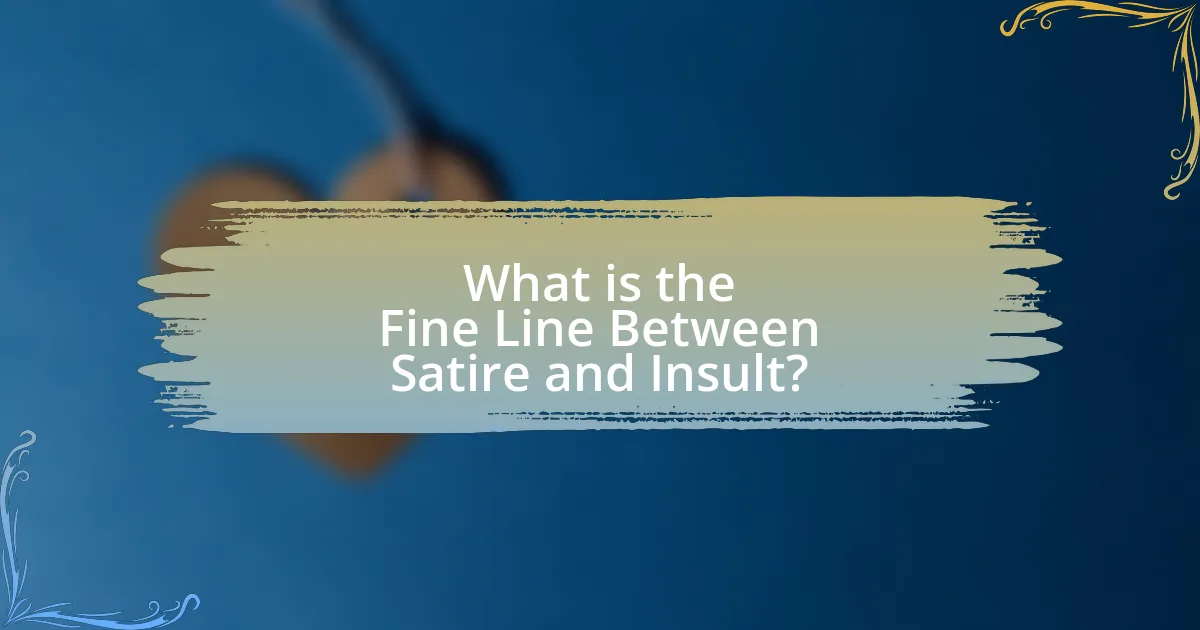
What is the Fine Line Between Satire and Insult?
The fine line between satire and insult lies in the intent and context of the humor. Satire aims to critique or highlight societal issues through exaggeration or irony, often with the goal of provoking thought or change, while insults are typically personal attacks meant to demean or belittle an individual without constructive purpose. For example, political cartoons often use satire to comment on government actions, whereas derogatory remarks about a person’s character serve only to offend. This distinction is crucial in understanding how humor can be wielded responsibly or irresponsibly in discourse.
How do we define satire in contrast to insult?
Satire is defined as a literary and artistic form that uses humor, irony, and exaggeration to criticize or mock societal norms, individuals, or institutions, often with the intent of provoking thought or change. In contrast, insult is a direct and often offensive remark aimed at belittling or offending someone without the intention of fostering critical reflection or dialogue. The distinction lies in satire’s constructive purpose, which seeks to highlight flaws for improvement, while insults are typically destructive, aiming solely to demean or provoke anger. This differentiation is supported by the historical use of satire in works like Jonathan Swift’s “A Modest Proposal,” which critiques social issues through irony, contrasting with straightforward insults that lack such depth or intent.
What are the key characteristics that differentiate satire from insult?
Satire is characterized by its use of humor, irony, and exaggeration to critique societal norms or individuals, while insult is primarily aimed at belittling or offending someone without a constructive purpose. Satire often seeks to provoke thought and encourage change by highlighting flaws in a humorous manner, as seen in works like Jonathan Swift’s “A Modest Proposal,” which critiques social issues through absurdity. In contrast, insults lack this critical intent and focus solely on personal attacks, as exemplified by derogatory remarks that aim to demean rather than enlighten. Thus, the key differentiation lies in satire’s constructive critique versus insult’s destructive intent.
How does context influence the perception of satire versus insult?
Context significantly influences the perception of satire versus insult by shaping the audience’s understanding and emotional response. When satire is presented in a context that highlights its intent to critique or provoke thought, it is often perceived as humorous and insightful. For example, political cartoons that exaggerate a politician’s actions can be seen as a form of social commentary rather than a personal attack. Conversely, if the same content is delivered in a hostile or derogatory context, it may be interpreted as an insult, leading to offense rather than amusement. Research indicates that the surrounding circumstances, such as the relationship between the speaker and the audience, cultural norms, and the medium of delivery, play crucial roles in determining whether a statement is viewed as satirical or insulting.
Why is understanding this distinction important?
Understanding the distinction between satire and insult is important because it influences how humor is perceived and received in social contexts. Satire aims to critique or highlight societal issues through humor, often encouraging reflection and dialogue, while insults typically aim to demean or belittle individuals without constructive intent. Recognizing this difference helps individuals navigate conversations responsibly, fostering an environment where humor can be used effectively to challenge norms rather than perpetuate harm. This understanding is supported by studies indicating that humor can either bridge gaps in communication or exacerbate conflicts, depending on its nature and intent.
What impact does misinterpreting satire have on social discourse?
Misinterpreting satire can significantly distort social discourse by fostering misunderstanding and polarization among individuals. When satire is taken literally, it can lead to outrage or misinformed reactions, which may escalate conflicts rather than promote constructive dialogue. For instance, a study published in the journal “Communication Research” found that audiences who misinterpret satirical content are more likely to engage in negative discussions and reinforce existing biases, thereby hindering open communication. This misinterpretation can also contribute to the erosion of trust in media and public figures, as individuals may perceive satire as an attack rather than a critique, further complicating the landscape of social interactions.
How can the misuse of humor affect relationships and communities?
The misuse of humor can significantly damage relationships and communities by fostering misunderstandings and perpetuating negative stereotypes. When humor is employed inappropriately, it can alienate individuals, create divisions, and escalate conflicts. For instance, research published in the Journal of Personality and Social Psychology indicates that humor that targets specific groups can reinforce prejudices and lead to social exclusion. This misuse can result in a breakdown of trust and communication, ultimately harming the cohesion of communities.
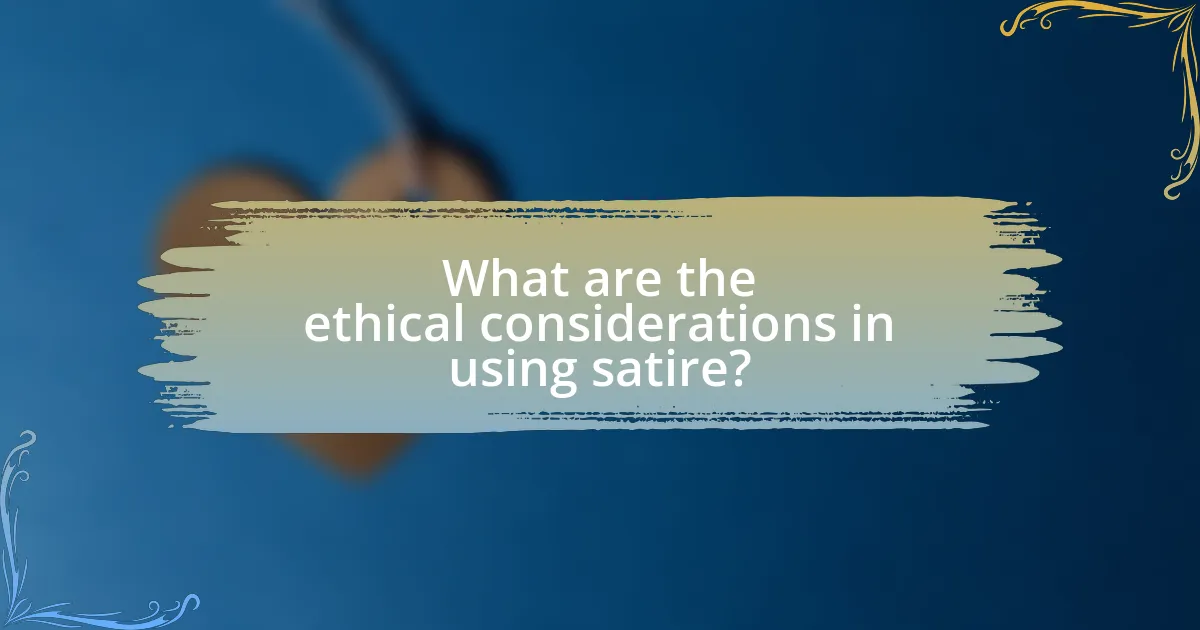
What are the ethical considerations in using satire?
The ethical considerations in using satire include the potential for harm, the intent behind the satire, and the context in which it is presented. Satire can critique societal norms and injustices, but it risks perpetuating stereotypes or offending marginalized groups if not handled carefully. The intent must be to provoke thought or highlight absurdities rather than to demean individuals or communities. Context is crucial; satire that is misinterpreted or lacks cultural sensitivity can lead to misunderstandings and backlash. Historical examples, such as the backlash against certain satirical cartoons, illustrate the fine line between humor and offense, emphasizing the need for responsible navigation of these ethical considerations.
How can humor be used responsibly in satire?
Humor can be used responsibly in satire by ensuring that it critiques ideas or behaviors rather than attacking individuals or marginalized groups. Responsible satire maintains a focus on social commentary, using humor to highlight absurdities or injustices while avoiding personal insults that can perpetuate harm. For instance, satirical works like “The Onion” often target societal norms or political issues, allowing audiences to reflect critically without resorting to derogatory language. This approach fosters constructive dialogue and encourages audiences to engage with the subject matter thoughtfully, rather than feeling alienated or attacked.
What guidelines can help ensure satire remains respectful?
To ensure satire remains respectful, creators should prioritize empathy and context. Empathy involves understanding the perspectives and experiences of the subjects being satirized, which helps avoid reinforcing harmful stereotypes or causing unnecessary offense. Context is crucial; satire should be relevant to current events or societal issues, allowing audiences to grasp the intended message without misinterpretation. Additionally, creators should consider their audience’s diversity, as different groups may interpret satire differently. By adhering to these guidelines, satirists can maintain humor while fostering a respectful dialogue.
How do cultural differences affect the reception of satirical content?
Cultural differences significantly influence the reception of satirical content by shaping individuals’ interpretations, humor sensibilities, and tolerance for criticism. For instance, in collectivist cultures, satire that targets group norms or values may be perceived as offensive, while in individualistic cultures, such content might be seen as a legitimate form of expression. Research indicates that humor appreciation varies across cultures; a study by Martin et al. (2003) found that cultural context affects humor styles, with some cultures favoring self-deprecating humor and others preferring more direct forms of satire. This variance underscores how cultural backgrounds can lead to divergent reactions to the same satirical piece, highlighting the necessity for creators to consider cultural sensitivities when crafting humor.
What are the potential consequences of crossing the line?
Crossing the line in humor can lead to significant social and personal consequences, including damaged relationships, public backlash, and potential legal repercussions. When humor shifts from satire to insult, it often alienates audiences and can provoke outrage, as seen in various public figures facing criticism for inappropriate jokes. For instance, comedians have faced career setbacks and loss of endorsements after crossing this line, highlighting the importance of understanding audience sensitivity and context.
What are the risks of offending audiences with poorly executed satire?
The risks of offending audiences with poorly executed satire include alienation, misinterpretation, and potential backlash. Poorly crafted satire can lead to misunderstandings where the intended humor is lost, causing audiences to perceive the content as offensive rather than comedic. For instance, a study by the Pew Research Center found that 60% of respondents felt that satire often crosses the line into offensive territory, indicating a significant risk of alienating viewers. Additionally, poorly executed satire can provoke strong negative reactions, resulting in public outrage or damage to the creator’s reputation, as seen in various instances where comedians faced backlash for insensitive jokes.
How can backlash from satire impact creators and their platforms?
Backlash from satire can significantly impact creators and their platforms by leading to reputational damage, loss of audience trust, and potential financial repercussions. When satire is perceived as offensive or inappropriate, creators may face public outrage, which can result in decreased viewership or engagement on their platforms. For instance, a study by the Pew Research Center found that 62% of Americans believe that satire can cross the line into offensive territory, indicating a substantial risk for creators who engage in this form of humor. Additionally, platforms may implement stricter content guidelines or face pressure from advertisers to distance themselves from controversial content, further affecting creators’ ability to monetize their work.
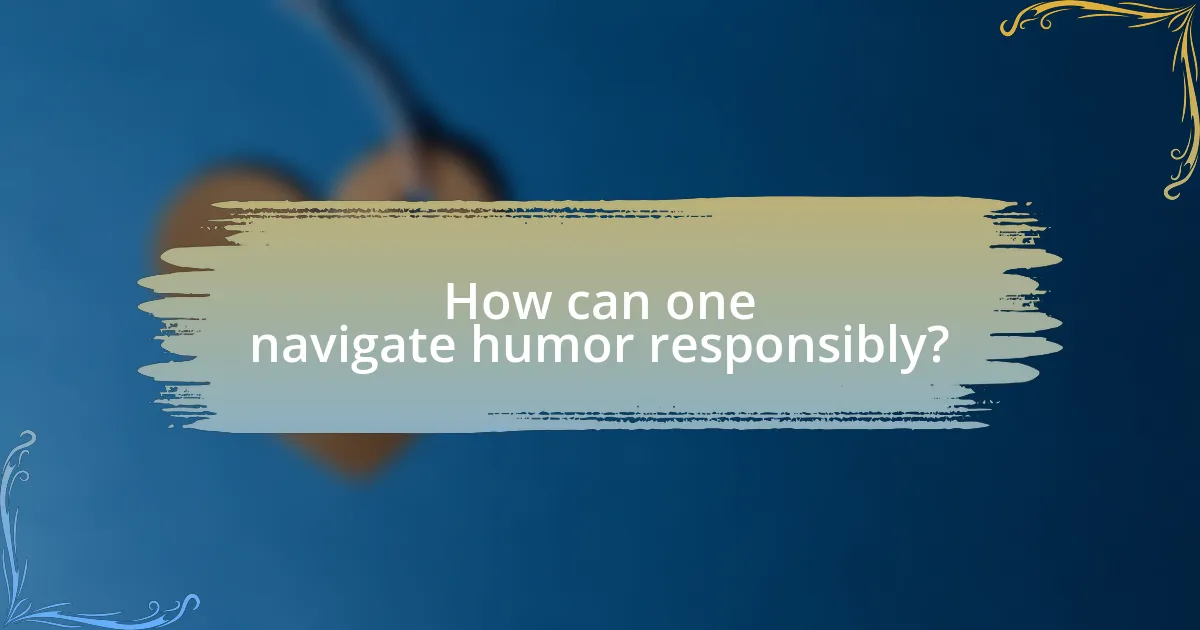
How can one navigate humor responsibly?
One can navigate humor responsibly by being mindful of the context, audience, and potential impact of their jokes. Understanding the sensitivities of different groups helps prevent offense and promotes inclusivity. For instance, humor that targets marginalized communities can perpetuate stereotypes and harm individuals, as evidenced by studies showing that derogatory humor can reinforce negative biases (Ford, M. T., & Ferguson, M. A., 2004, “Social Psychological and Personality Science”). Additionally, employing self-deprecating humor or light-hearted observations about universal experiences can foster connection without alienating others. By prioritizing empathy and awareness, individuals can ensure their humor is both enjoyable and respectful.
What strategies can help in crafting effective satire?
Effective satire can be crafted by employing strategies such as exaggeration, irony, and social commentary. Exaggeration amplifies the absurdity of the subject, making it more recognizable and relatable to the audience. Irony highlights the contrast between reality and expectations, allowing the audience to see the flaws in the subject matter. Social commentary provides context, addressing relevant societal issues, which enhances the impact of the satire. For instance, Jonathan Swift’s “A Modest Proposal” uses these strategies to critique British policy towards the Irish, effectively illustrating the dire situation through shocking exaggeration and irony.
How can one assess the appropriateness of a satirical piece before sharing it?
To assess the appropriateness of a satirical piece before sharing it, one should evaluate the context, audience, and intent of the satire. Context involves understanding the cultural and social background surrounding the piece, as satire can be misinterpreted if the audience lacks familiarity with the subject matter. The audience’s values and sensitivities must also be considered, as humor that targets marginalized groups can perpetuate harm rather than provoke thought. Lastly, the intent behind the satire should be clear; it should aim to critique or highlight issues rather than simply insult or demean individuals. Evaluating these factors helps ensure that the satire is constructive rather than harmful.
What role does audience awareness play in responsible humor?
Audience awareness is crucial in responsible humor as it ensures that the humor resonates appropriately with the audience’s values, experiences, and sensitivities. By understanding the audience’s context, humorists can avoid reinforcing stereotypes or causing offense, thereby fostering a more inclusive environment. Research indicates that humor that aligns with the audience’s cultural and social backgrounds is more likely to be received positively, while humor that disregards these factors can lead to misunderstandings or backlash. For instance, a study published in the Journal of Communication found that humor perceived as offensive often stems from a lack of audience awareness, highlighting the importance of tailoring humor to the audience’s expectations and norms.
What are some best practices for using humor in communication?
Best practices for using humor in communication include understanding your audience, ensuring appropriateness, and using humor to enhance the message rather than distract from it. Understanding your audience allows you to tailor humor to their preferences and sensitivities, which is crucial for effective communication. Ensuring appropriateness means avoiding humor that could be offensive or misinterpreted, as this can lead to misunderstandings or negative reactions. Additionally, humor should serve to clarify or emphasize key points, making the communication more engaging and memorable. Research indicates that humor can improve retention of information and foster a positive atmosphere, as shown in studies by the University of Maryland, which found that humor can enhance learning and engagement in educational settings.
How can humor be used to foster understanding rather than division?
Humor can foster understanding rather than division by promoting empathy and shared experiences. When humor highlights commonalities among diverse groups, it encourages individuals to see perspectives beyond their own. For instance, studies show that laughter can reduce tension and create a sense of belonging, as evidenced by research from the University of California, which found that humor can bridge cultural gaps and enhance interpersonal connections. By using humor to address sensitive topics in a light-hearted manner, individuals can engage in constructive dialogue, ultimately leading to greater understanding and reduced conflict.
What are common pitfalls to avoid when using satire in public discourse?
Common pitfalls to avoid when using satire in public discourse include misinterpretation, insensitivity, and overgeneralization. Misinterpretation occurs when the audience fails to grasp the satirical intent, leading to unintended offense or confusion. Insensitivity arises when satire targets vulnerable groups or sensitive topics, potentially perpetuating harm rather than fostering dialogue. Overgeneralization happens when satire simplifies complex issues, resulting in misleading representations that can distort public understanding. These pitfalls can undermine the effectiveness of satire and detract from meaningful discourse.
How can individuals improve their understanding of satire and insult?
Individuals can improve their understanding of satire and insult by actively engaging with diverse forms of media that utilize these techniques, such as literature, film, and social commentary. Analyzing works by renowned satirists like Jonathan Swift or George Carlin can provide insights into the nuances of satire, while studying the context and intent behind various insults can clarify the distinction between humor and offense. Research indicates that exposure to different cultural perspectives enhances comprehension of humor, as demonstrated in studies published in the Journal of Cross-Cultural Psychology, which show that understanding humor varies significantly across cultures and contexts. By critically evaluating the intent, audience, and context of satirical content, individuals can better discern the fine line between satire and insult.
What resources are available for learning about responsible humor?
Resources for learning about responsible humor include books, online courses, and workshops focused on humor theory and ethics. Notable books such as “The Humor Code” by Peter McGraw and Joel Warner explore the psychology of humor and its societal implications, providing insights into what constitutes responsible humor. Online platforms like Coursera and Udemy offer courses on comedy writing that emphasize the importance of context and audience sensitivity. Additionally, organizations like the Humor Research Lab provide research and guidelines on humor’s impact, helping individuals navigate the fine line between satire and insult.
How can engaging with diverse perspectives enhance one’s approach to humor?
Engaging with diverse perspectives enhances one’s approach to humor by broadening the understanding of cultural nuances and social contexts. This expanded awareness allows individuals to create humor that resonates with a wider audience while avoiding stereotypes and offensive content. Research indicates that humor often relies on shared experiences and cultural references; thus, exposure to varied viewpoints fosters creativity and depth in comedic expression. For instance, a study published in the Journal of Cross-Cultural Psychology found that humor appreciation varies significantly across cultures, highlighting the importance of inclusivity in comedic content. By integrating diverse perspectives, humor becomes more relatable and impactful, ultimately promoting empathy and connection among different groups.
